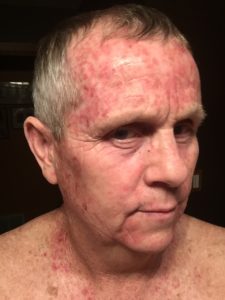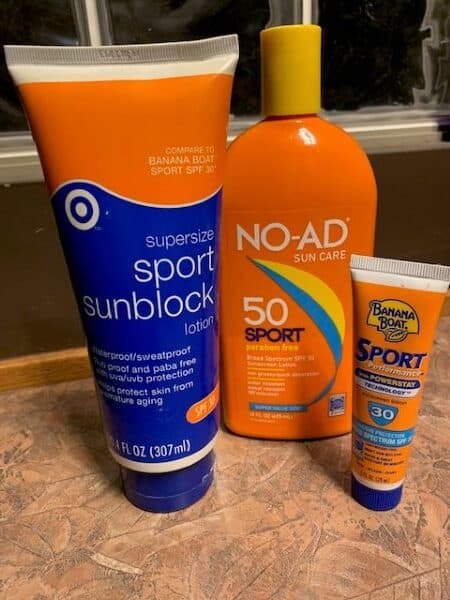UV Rays and Sunscreen
Table of Contents
At last, summer is here. Little league is in full swing. Golf leagues are starting. Soon it will be trips to the lake for swimming, skiing and a whole host of water sports! After a long cold winter, there’s nothing like a bright sunny day to lift your spirits and ward off the “cabin fever”. It also helps the body produce vitamin D, which has numerous health benefits.
However, too much sun can have some adverse effects, if you don’t take precautions. The ultraviolet (UV) rays the sun emits are the culprits that cause those irritating, and sometimes outright painful, sunburns that we are all familiar with! But did you know that repeated and prolonged exposure to the sun’s rays can cause more serious effects? Did you know that years of excessive exposure to the sun can lead to premature aging of the skin and wrinkling? Is it really worth the trade-off for that bronze-colored skin?
Skin Damage
On a more serious note, repeated exposure to the sun can lead to skin cancer, as well. Some UV rays (uva) are out there during all daylight hours and they penetrate clouds and glass. Did you know that the tanning beds, that give you that wonderful bronze skin, emit the same UV rays as the sun? In fact, I’ve read that some of these beds can emit up to 12 times the UV rays as the sun! Individuals with fair skin are particularly susceptible to the accumulative effects of the sun.
I was one of those youngsters known as a “tow-head”. Blonde hair, light-skinned, and I sunburned easily. I loved the outdoors and spent every moment outside that I could. Even into my adult life, I spent a lot of time outside. Today I am paying the price for all of that exposure to the sun. Approximately 20 years ago I had a spot on my neck that would turn bright red after showing and was quite sensitive when I would shave. After a couple of months, it was not getting any better so I decided it was time to have it looked at. Okay, my wife decided I needed to get it looked at!
The Diagnosis
To make a long story short I went to a dermatologist and he diagnosed the spot as basal cell carcinoma. One of several types of skin cancer. I was told of all skin cancers this was the best one to have. It rarely spreads to other parts of the body and it is treatable. Since then I get a checkup yearly, or if I have a suspicious spot that shows up. To date, I have had at least four spots surgically removed and many more “precancerous” spots frozen off with liquid nitrogen, which stings and leaves a nice puffy patch of skin that eventually scabs over. Not a pretty sight when you have 6 or 7 of those on your face!
Recently at a check-up, my doctor noted several pre-cancerous spots on my face, neck, and ears. The doctor recommended using a new treatment, which was a cream that you apply 2 times a day, for 2 weeks. This cream only affects the bad tissue and does nothing to the healthy tissue. That sounded good to me! No stinging liquid nitrogen and no scabs. Sign me up! After a week of applying the cream, I started seeing a few spots, which was exactly what the doctor said would happen.

But it was what happened the second week that I was not expecting. I looked like I’d been hit in the face with a bag of marbles… repeatedly. I had spots everywhere! There was a lot of redness and it was quite sensitive. When I went back to the doctor at the end of 2 weeks, she was very pleased! This was what I needed. Things are healing up nicely!
Protect Yourself
The actual purpose of this article was to promote the use of sunscreen! I’ve learned my lesson the hard way! I am still far luckier than others who have been diagnosed with other, more serious, forms of skin cancer. I wanted to share my experience in hopes that you may avoid going through something similar, or worse.
There are many types of sunscreen to pick from. There are lotions, creams, and even sprays. They make some that are waterproof, for at the beach, and others that are sweatproof, for all you athletes. The “sun protection factor” (SPF) can range from 4 SPF to over 80 SPF. It is recommended to use at least a 15 SPF or greater and to re-apply it every couple hours. Be sure to protect your children and infants. By starting them at a young age, you’ll reinforce the behavior of using sunscreen and they will be the ones who benefit the most later in life.
Please consider buying and using sunscreen to protect your skin on a regular basis. That includes winter and summer. There are a ton of reports out on the internet if you are interested in more detailed information. Also don’t hesitate to see a dermatologist if you have a new, or unusual spot. If this article helps at least one person who reads it, this will be one of our greatest recipes for success!
If you have any comments or questions, you can leave them in the comments section below or you can email us at [email protected]. FYI, we do not collect or share email addresses. We will only use them to reply to your comments or provide answers to your questions. We are also required to let you know that some of our links are “affiliate links”. This means if you click on a link and make a purchase, we could make a small commission, at no extra cost to you. This helps offset the cost of maintaining our website. So, if you like what you’ve seen, please be sure to give us a “Like” and “Share” on Facebook and Instagram too. Thank you for reading and good luck with all your home projects!

